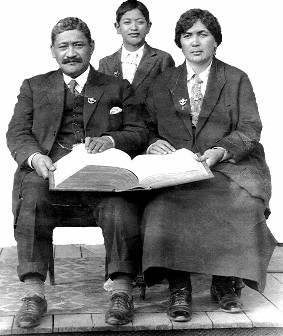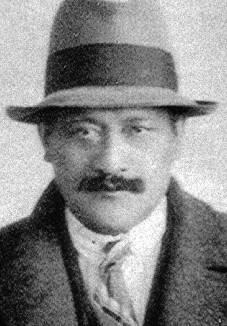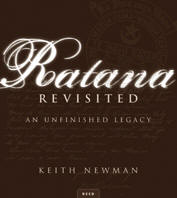 Ratana
legacy Ratana
legacy
supercedes Labour
How
the man and the movement forced the Treaty back onto the political
agenda
Keith
Newman
(First published in July 2006 by Just Change,
a publication of
Dev-Zone (www.dev-zone.org), an arm of the Development Resource Centre (DRC),
a not-for-profit, non-governmental organisation governed by a charitable
trust.
Without the efforts of Tahupotiki Wiremu Ratana and his followers, the
Treaty
of Waitangi may have remained a ‘nullity’, a mere curiosity, rather
than its growing stature today as the birth certificate and founding
document of the nation.
There’s no
question Ratana helped lay the groundwork for the current renaissance of
all things Māori despite the fact a number of modern publications on the
subject of the Treaty of Waitangi do not even mention his name.
Seeing T.W. Ratana languishing between pioneering broadcaster Aunt Daisy
and the original Tuhoe activist Rua Kenana near the bottom of a ‘Top 100
History Makers’ list in November 2005, made me realise how little we
understand his
contribution.
That’s probably not surprising, as nothing substantial has been
published about his life or the movement he founded since 1972 when Jim
McLeod Henderson summarised and re-published his research in the book
Ratana, the Man, the Church, the Political Movement.
 Even
Ratana faithful have a hard time getting access to information about the
movement’s history or material that records the words and actions of the
man who was a political visionary and undoubtedly one of Aotearoa New
Zealand’s most powerful faith healers and Māori leaders. Even
Ratana faithful have a hard time getting access to information about the
movement’s history or material that records the words and actions of the
man who was a political visionary and undoubtedly one of Aotearoa New
Zealand’s most powerful faith healers and Māori leaders.
T.W. Ratana set out on a series of nationwide and world tours between
the two world wars, promising to breathe life back into the Treaty of
Waitangi and restore Māori mana.The pan-tribal movement he founded had a
profound impact, rallying the spirits of the dispossessed and scattered
tribes of Māoridom.
"There’s no question Ratana helped lay the ground work
for the current
renaissance of all things Māori."
During a vision in 1918, at his farm between Wanganui and Palmerston
North, he had been told to heal the people and turn Māori away from
their belief in the old gods or atua Māori and urge them unite under one
God (Ihoa), Jehovah of the thousands (the Ture Wairua or the
spiritual law). The second part of his mission was the Ture Tangata
(the physical law), where he gathered signatures for a petition and
evidence about land confiscation to convince the government to make the
Treaty of Waitangi part of the law of the land.
In 1924, Ratana and a party of 40 followers including musicians and
cultural performers paid their own way to England to attend the British
Exhibition and try to gain an audience with British Government officials
and King George V to present the petition which contained the names of
two thirds of all Māori. He had with him a Māori copy of the Treaty
of
Waitangi and sought confirmation from the Crown that it would be
honoured. However everywhere he went, letters from the Aotearoa New
Zealand Government had been sent insisting the group did not represent
Māori.
From
1928, after he had built the Ratana Temple and allowed the Ratana Church
to be established, the prophet and healer said he would divide his body
into four quarters, to win the Māori seats in Parliament. Their main
goal would be to have the Treaty of Waitangi honoured and to improve
conditions for all Māori. In 1932, his first successful candidate,
Eruera Tirikatene, tabled the Ratana petition, which now contained
45,000 signatures and weighed in at 16 pounds (7.25kg). It was
requested that the Treaty of Waitangi be entered into the statute books
in an effort to “preserve the ties of brotherhood between Māori and
Pakeha for all time”.
The petition was ignored for many decades, and even today its requests
have not been completely met.Ratana entered into the legendary
‘alliance’ with the Labour Party (Ngati Kai Mahi) because he saw that
the ideals and goals of Michael Joseph Savage and his ‘Christian
socialism’ aligned with his own goals of raising the bar for the
carpenters, shoemakers and blacksmiths – the ordinary people, of King
Tawhiao’s prophecy. While the Ratana Independent candidates and many of
Ratana’s followers joined Labour, their loyalty remained principally
with Ratana. The relationship was always predicated on Ratana’s 1936
warning to Savage: “May you never forget your responsibilities to the
Māori people, for when you forget this, your government will fall.”
Tirikatene was joined by three other Ratana candidates before the end
of the Second World War. Nga koata e wha were backed and informed by an
enormous network of advisors from across Māoridom. However, after the
death of their greatest advocate Michael Joseph Savage, the Ratana MPs
were regularly sidelined, over-ridden and dismissed in their efforts to
introduce legislation and establish structures that would bring Māori
closer to equality.
The Treaty continued to gather cobwebs until former Ratana youth leader
Matiu Rata eventually pushed through legislation in 1974 recognising
Waitangi Day as a national holiday, and paved the way for the Waitangi
Tribunal to begin investigating breaches of the agreement between the
two peoples in 1976.
Despite the Ratana-Labour alliance eventually pushing through
significant legislation that recognised Māori concerns, Labour’s efforts
to undermine the Ratana ability to ‘block vote’ remained a sore point.
This was evidenced even in recent years through the ‘unconstitutional’
actions of the Labour Party in 1999, which deregistered the 4000-strong
Maramatanga Affiliate despite their fees and membership being up to
date. This effectively shut down the powerful Ratana-based network,
which dated back to the 1930s.
Regardless, politicians still turn up in their droves to Ratana Pa every
January 24th for Ratana’s birthday celebrations. There are many factions
at work seeking to harness the political potential of the Ratana
movement. While Māori Party co-leader Tariana Turia was brought up a
Ratana, and many Ratana are keen to support her and her political
aspirations, Labour continues to hold tenuously to an ancient and much
compromised alliance.

While Ratana is better known for its political heritage, it remains
largely a spiritual movement, strongly influenced
by the original Christian-based kaupapa, and the prophecies and sayings
of its founder. There is a strong undercurrent within the church and
movement to return to its turangawaewae or foundation. Pivotal
among these are the words T.W. Ratana used frequently during his
mission: “In one of my hands is the Bible; in the other the Treaty of
Waitangi. If the spiritual side is attended to, all will be well on the
physical side.”
References
Love, Ralph N. 1977, Policies of frustration: The growth of Ma-ori
politics: The Ratana/Labour era (Masters Thesis), Victoria
University of Wellington
Henderson, J. 1972, Ratana: The man, the
church, the political movement, A. H. & A. W. Reed, Wellington
Caption:
T.W.
Ratana, his wife Urumanao (Te Whaea) and their son Te Omeka with the
large family Bible outside their homestead at Ratana Pa.
Photo: Ratana Archives |
 Ratana
legacy
Ratana
legacy 

